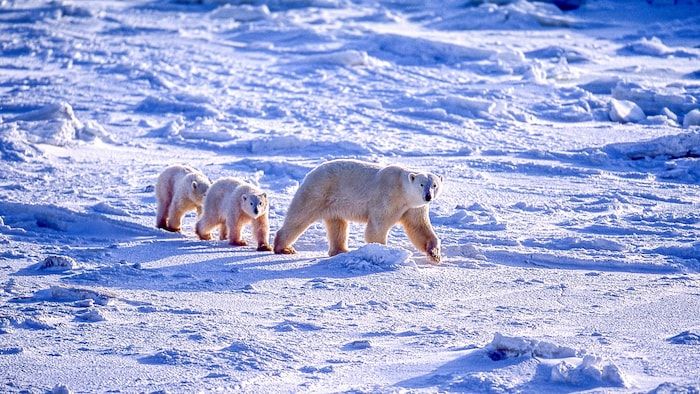Increasing ice-free periods at sea are directly linked to this grim prognosis for the Hudson Bay polar bear.
The animal needs this ice cover to hunt seals and eat properly.
In the absence of ice floes, while on dry land, the polar bear loses on average (new window) one kilogram of body mass per day, which harms its reproductive capacities.
If the bear does not accumulate enough fat before this annual fast, the bear’s health deteriorates.
Photo: Radio-Canada / Provided by David McGeachy
The authors of this new study (new window)from different universities and research centers, therefore analyzed around twenty climate models.
The goal was to predict the threshold of warming that would be fatal for the survival of the bear in Hudson Bay.
We decided to focus on the length of ice-free periods based on global temperatures.
I believe it is important for us to understand the impact of our warming targets, at 1.5°C and even 2°C, on a species as important as the bear
continues Professor Julienne Stoeve, from the University of Manitoba, who is one of the lead authors of the study.
The scientist works at the Center for Earth Observation Science, a research center linked to the University of Manitoba.
Photo: Provided by Julienne Stroeve
A deadly fast
The researchers thus divided Hudson Bay into two distinct study regions.
In southern Hudson Bay, they predict that the bear could disappear from an average warming of 1.6°C.
At this threshold, it is likely that this area would be ice-free for 172 to 182 days per year, which would be dramatic for the bear’s reproductive capabilities.
Start of the Widget widget. Skip the widget?
End of widget Widget. Return to start of widget?
A little further north, in western Hudson Bay, the decline could be felt more slowly, as ice forms earlier in the year.
Western Hudson Bay would be inhospitable for bears at an average warming of 2.2°C. In such a case, the number of days without ice in the year would vary between 180 and 200 days, which would also be dramatic for the animal.
Rapid decline
The current climate has already warmed by about 1.2°C compared to pre-industrial times, and it is very likely that we will reach 1.5°C by 2030-2035, according to the most recent report of Intergovernmental Panel on Climate ChangeIPCC.
At this rate, researchers believe that polar bears could gradually disappear from southern Hudson Bay from 2030, until the middle of this century.

Bears cannot adapt to a life without ice. (Archive photo)
Photo: iStock / Gomez David
The loss of the animal would be quite tragic for the communities of the region, since the polar bear has great cultural significance.
The authors of the study therefore broadly underline the importance for governments to implement concrete and rapid measures to reduce greenhouse gas emissions.
This report is more detailed and alarming than previous studies, reinforcing the fact that Hudson Bay polar bears are not on a good trajectory unless significant emissions mitigation measures are taken.
underlines study co-author Geoff York, senior director of research and policy at Polar Bears International.
Signs already visible
The consequences of climate change on polar bears are already being felt in the region.
In 2021, researchers estimated the population (new window) The current number of bears in western Hudson Bay is 618. This is more than a quarter less than in 2016, the date of the last census, which estimated 842 bears.

The species is experiencing a brutal decline, with numbers estimated to have fallen by 50% since 1980. (Archive photo)
Photo: iStock / nicholas_dale
As one of the southernmost subgroups of polar bears on the planet, they are among the first to suffer the consequences of global warming.
Other studies point out that the animal could completely disappear from the Arctic by the end of the century if the warming trend continues.
There are currently some 25,000 polar bears, divided into 19 distinct subpopulations in Canada, Alaska, Siberia, the Svalbard archipelago and Greenland.









